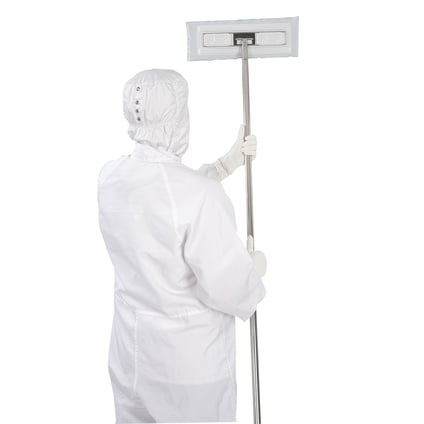Details Make the Difference for Successful Disinfection
Disinfectant manufacturers work hard to test and document the effectiveness of disinfectant solutions. End users invest time and money to determine the bioburden and local isolates of their facility. This testing and documentation is vital to the proper selection of disinfectants. It is essential in the Life Sciences and pharmaceutical, biologics, medical device and animal health industries to keep tight control of the microorganisms within a given facility. Often, tools (mops, wipes) or protocols are overlooked, thereby reducing the effectiveness of the disinfection process.
It is essential in the Life Sciences and pharmaceutical, biologics, medical device and animal health industries to keep tight control of the microorganisms within a given facility. Often, tools (mops, wipes) or protocols are overlooked, thereby reducing the effectiveness of the disinfection process.
Manufacturers of the disinfectant solution have done extensive validation work to prove that their solution will kill a range of microbiologic contamination per the EPA requirements for standarize testing conditions for disinfectant registration. The lab setting does not always simulate variables that exist in real world facilities.
Quality departments spend time performing environmental monitoring to document the bioburden and identify local isolates in a facility. Samples are taken, incubated, and identified. A systematic approach determines the best disinfectant solution needed to keep the identified organisms under control in the facility. Once the proper disinfectant is chosen, it is up to the operator or cleaning company to use the approved products appropriately for successful disinfection. It is easy to overlook small variables that will cause improper disinfection of surfaces, including the fiber from which a mop or wipe is made, the protocols for applying disinfectant solutions, and how these protocols are interpreted and implemented by workers in the facility.
First, it is important to read the disinfectant label, as it will provide instructions for use including the appropriate contact (dwell) time required to kill specific microorganisms.
Improper protocols set by the end user can also affect the effectiveness of the disinfection program. Disinfectants have a required contact time to achieve the kill claims of the manufacturer. If the protocol used to apply the solutions does not allow for the solution to stay on the surface for the appropriate contact time, the reduced bioburden is not achieved. One example of this would be using an automatic floor scrubber to apply the solution. This method will do the job quickly, but these machines usually have squeegees on the back with vacuums that remove the solution from the surface as soon as it is applied, leading to inadequate contact times. Even if the squeegees are removed, the operator will walk over the area where they just applied the solution, contaminating the cleaned floor.
Vertical surfaces are also hard to disinfect correctly. When disinfectant solutions are applied to a vertical surface, they dry faster than they would on a floor. End users should be sure they time how long a vertical surface stays wet. If the contact time of the solution is not achieved, a second or third application of the solution may be needed for effective disinfection. A different solution that offers a shorter contact time for the microorganism being targeted should also be considered.
Selection of proper tools and disinfectant solutions are essential to an effective decontamination of the area. This will insure the chemical can eliminate the microorganisms in question, ergonomics for the users have been considered and that the tools selected are chemically compatible with the solution and appropriate for the environment where they are to be used.
Multiple studies have shown that natural fibers like cotton, cellulose and even rayon can negatively affect the efficacy of disinfectant solutions. Certain solutions are more susceptible than others to this effect. Hypochlorite solutions (bleach) and quaternary ammonium (quats) solutions are prime examples. When natural fiber wipes or mops are placed into a ready-to-use (RTU) disinfectant solution, the active ingredient in the solution can bind with the mop material. Once this occurs, the solution no longer has the proper strength to achieve the kill claims of the manufacturer, leading to ineffective disinfection. Mops and wipes constructed from synthetic products like polyester and polypropylene do not exhibit this binding phenomenon, and are more appropriate choices for applying disinfectants.
Natural fibers, especially if not dried properly, can also grow bacteria. Care should be taken to properly clean and dry natural fiber mops if re-using. Single use mops and wipes reduce the opportunity for cross contamination.
Disinfection should be treated as three processes.
- Cleaning or removal of the “soil load” from surfaces
- Application of the disinfectant solution with proper contact time
- Removal of any residues remaining from the disinfection process
In summary, all factors should be considered when establishing systems to control the bioburden in a facility. Just because a solution can kill a specific microorganism does not mean it will. Following disinfectant label directions, choosing the appropriate applicators and applying the solutions properly, all lead to successful disinfection.
References:
- IEST-RP-CC004: Evaluating Wiping Materials Used in Cleanrooms and Other Controlled Environments Aug 2004 Institute of Environmental Sciences and Technology
- D. MacDougall and C Morris, Infection Control Today, Vol 10 (June 2006)
- V. Williamson, Infection Control Today, Vol 11 No 8 (Aug 2007)
- R. Bloss, S Meyer, G. Kampf, Journal of Hospital Infection, Vol 75 (Nov 2010)
- K. Rossington, Cleanroom Technology, The International Journal of Contamination Control, (June 2013)
